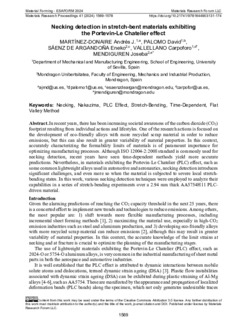| dc.rights.license | Attribution 4.0 International | * |
| dc.contributor.author | Sáenz de Argandoña, Eneko | |
| dc.contributor.author | Mendiguren, Joseba | |
| dc.contributor.other | Martínez-Donaire, Andrés J. | |
| dc.contributor.other | Palomo, David | |
| dc.contributor.other | Vallellano, Carpóforo | |
| dc.date.accessioned | 2024-07-02T08:56:37Z | |
| dc.date.available | 2024-07-02T08:56:37Z | |
| dc.date.issued | 2024 | |
| dc.identifier.other | https://katalogoa.mondragon.edu/janium-bin/janium_login_opac.pl?find&ficha_no=177656 | en |
| dc.identifier.uri | https://hdl.handle.net/20.500.11984/6565 | |
| dc.description.abstract | In recent years, there has been increasing societal awareness of the carbon dioxide (CO2) footprint resulting from individual actions and lifestyles. One of the research actions is focused on the development of eco-friendly alloys with more recycled scrap material in order to reduce emissions, but this can also result in greater variability of material properties. In this context, accurately characterizing the formability limits of materials is of paramount importance for optimizing manufacturing processes. Although ISO 12004-2:2008 standard is commonly used for necking detection, recent years have seen time-dependent methods yield more accurate predictions. Nevertheless, in materials exhibiting the Portevin-Le Chatelier (PLC) effect, such as some common lightweight alloys used in automotive and aeronautics, necking detection introduces significant challenges, and even more so when the material is subjected to severe local stretchbending states. In this work, various necking detection techniques were employed to analyze their capabilities in a series of stretch-bending experiments over a 2.94 mm thick AA5754H11 PLCdriven material. | en |
| dc.language.iso | eng | en |
| dc.publisher | Materials Research Forum LLC | en |
| dc.rights | © 2024 The Authors | en |
| dc.rights.uri | http://creativecommons.org/licenses/by/4.0/ | * |
| dc.subject | necking | en |
| dc.subject | Nakazima | en |
| dc.subject | PLC effect | en |
| dc.subject | stretch-bending | en |
| dc.subject | time-dependent | en |
| dc.subject | Flat Valley method | en |
| dc.title | Necking detection in stretch-bent materials exhibiting the Portevin-Le Chatelier effect | en |
| dcterms.accessRights | http://purl.org/coar/access_right/c_abf2 | en |
| dcterms.source | Materials Research Proceedings | en |
| local.contributor.group | Procesos avanzados de conformación de materiales | es |
| local.description.peerreviewed | true | en |
| local.description.publicationfirstpage | 1569 | en |
| local.description.publicationlastpage | 1578 | en |
| local.identifier.doi | https://doi.org/10.21741/9781644903131-174 | en |
| local.contributor.otherinstitution | https://ror.org/03yxnpp24 | es |
| local.source.details | 2024. Vol. 41. Pp. 1569-1578 | |
| oaire.format.mimetype | application/pdf | en |
| oaire.file | $DSPACE\assetstore | en |
| oaire.resourceType | http://purl.org/coar/resource_type/c_c94f | en |
| oaire.version | http://purl.org/coar/version/c_970fb48d4fbd8a85 | en |
| oaire.funderName | Gobierno de España | en |
| oaire.funderIdentifier | https://ror.org/038jjxj40 / http://data.crossref.org/fundingdata/funder/10.13039/501100010198 | en |
| oaire.fundingStream | Programa Estatal para Impulsar la Investigación Científico-Técnica y su Transferencia 2021 | en |
| oaire.awardNumber | PID2021-125934OB-I00 | en |
| oaire.awardTitle | Caracterización experimental y numérica de la conformabilidad de rebordeado convencional e incremental de aleaciones de aluminio aeronáuticas durante el envejecimiento natural | en |
| oaire.awardURI | https://investigacion.us.es/sisius/sis_proyecto.php?ct=1&cs=1&idproy=35443 | en |








